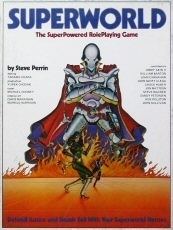Publication date 1983 System(s) Basic Role-Playing | ||
 | ||
Designer(s) Steve PerrinSteve Henderson | ||
Superworld is a superhero-themed role-playing game published by Chaosium in 1983. Written by Basic Role-Playing and RuneQuest author Steve Perrin, Superworld began as one third of the Worlds of Wonder product, which also included a generic fantasy setting, "Magic World", and a generic science fiction setting, "Future World", all using the same core Basic Role-Playing rules. Only Superworld became a game in its own right.
Contents
Game system
Superworld is based on the traditional Chaosium Basic Role-Playing system augmented by super-powers.
Seven characteristics (Strength, Constitution, Size, Intelligence, Power, Dexterity, Appearance) are rolled with dice (2D6+6, rather the 3d6 used for many other Basic Role-Playing games.) The sum of these characteristics gives a total of Hero Points used to buy super powers.
The super powers system follows the Champions model of powers that are described by their effects. For example, one does not buy "Laser Vision", but the effect "Energy Blast" and specifies that it is a laser emitted by the hero's eyes. Each effect can be modified by Advantages (less energy expenditure, for example) or Disadvantages (reduced number of uses, for example) which increase or reduce the cost of a power.
Hero Points can also be used to buy skills or increase characteristics. It is possible to get more Hero Points for character creation by choosing Disabilities for the character, such as Public Identity, Vulnerability to a Substance, Psychological Problems, etc. More Hero Points would be awarded for experience at the end of a game session.
The system functions in the same way as the other Basic Role-Playing games, by rolling percentile dice against skills. Lower rolls than needed can cause increased effect from Specials (equivalent to Impales in RuneQuest), or Criticals, and high rolls can cause critical failures (Fumbles). Combat rules have many options and take into account three types of energy for damage: Kinetic, Electric, and Radiation.
Game materials
The game box contains three rules booklets, a booklet of character sheets, one of tables for the Gamemaster, a page of cardboard figure silhouettes to be cut out, and a set 6, 8, and 20-sided dice. 1984 printings also contains a 4-page errata booklet.
Bad Medicine for Dr. Drugs
(1984) Scenario. Author: Ken Rolston. Set in a high school, and designed for teenage characters. It comes with six young pregenerated heroes, or lets players use their own. Beginning with the funeral of one of their friends, it sets the heroes on the track of a drug distribution network in their school, directed by the aforementioned Dr. Drugs.
It also includes rules for the creation and management of adolescent characters that have just discovered their powers, and a plan of Warren G. Harding High School, though the scenario recommends substituting the school in which the GM and the players studied.
Superworld Companion
(1985) Rules supplement. Many authors: Stephen R. Marsh, Stephen Perrin, Ian Lee Starcher, Anthony Affronti, Jimmy Akin II, William A Barton, Norman Doege, Bruce Dresselhaus, Ray Greer, Zoran Kovacich, George MacDonald, Steve Maurer, Sandy Petersen, Wayne Shaw, John Sullivan—most are listed because they provided one or more optional rules.
Includes:
Trouble for HAVOC
(1984) Scenario / Campaign. Authors: Stephen Perrin, Yurek Chodak, Donald Harrington, Charles Huber. A linked collection of three scenarios based on the members of the criminal organization HAVOC. All the characters are presented with characteristics for with three different systems, Superworld, Champions and Villains & Vigilantes. Each may be played separately, or as part of a campaign.
Wild Cards
The Wild Cards series of science fiction books came from an Albuquerque, New Mexico campaign gamemastered by George R. R. Martin, and played in by other science fiction writers.
